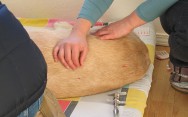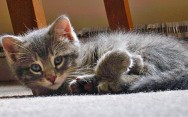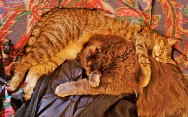Acupuncture and Your Pet
Frequently Asked Questions
Acupuncture FAQs answered. Learn more about how this complementary and noninvasive treatment can help your pet.
-
How Does Acupuncture Work?Open or Close
The vital energy of the body, called Qi (pronounced 'chee'), circulates all through the major organs and the head and extremities in circulatory channels called meridians. Acupuncture treats disease by accessing those meridians by the insertion of needles into certain designated points. If the flow of Qi is smooth and in balance, the pet is healthy. If it is blocked or disturbed, there is illness or pain. The stimulation of specific points along the meridians can help to regulate and balance the flow of energy in the meridians and their related organs, and the health of the animal can be restored. Acupuncture can be used to treat diseases, and also to strengthen the body and prevent disease.
-
What Conditions Can Benefit From Acupuncture?Open or Close
There are many situations where acupuncture is useful, alone or in conjunction with chiropractic and nutritional therapy. Acupuncture should always be considered when an animal has not responded to conventional medicine. It is a tool for us to use in addition to the other wonderful medical and surgical tools that we as veterinarians can offer your pets.
- Arthritis – This is one of the most common ailments that we see in our clinic. Acupuncture can be quite effective in easing the pain and increasing the mobility of these animals.
- Geriatrics – Older animals are especially appreciative of the boost in physical strength they derive from periodic acupuncture treatments.
- Neurologic conditions – Epileptics whose seizures are not adequately controlled by conventional medication, paralyzed animals who have not responded to conventional medication, and those with neurologic deficits and loss of control over their limbs are some examples of patients whose owners found hope and success with acupuncture treatment for their pets.
- Gastrointestinal Problems – Nausea, vomiting, diarrhea and constipation can all be effectively treated with acupuncture.
- Musculoskeletal Strains and Pains – Back soreness, hind end weakness, ligament and tendon damage (though not rupture) and muscle pain can be significantly eased by acupuncture and chiropractic treatment.
- Internal Medical Problems – Liver and kidney disease are well suited to nutritional therapy and can be helped by acupuncture as well. Best results are seen early in the course of disease, when establishing energy flow and balancing Qi can have a beneficial effect, rather than waiting for severe organ damage to occur.
- Behavioral Troubles – Problems with an animal’s disposition can be related to organ imbalance as well as physical pain, both of which are treatable with acupuncture.
-
How Many Treatments are Necessary?Open or Close
Each treatment plan is individualized, depending on the particular animal’s condition and response. For most conditions, we do weekly treatments for the first 3 to 6 visits, and most beneficial reactions will start within that time. Sometimes that is all that is needed. In very acute injuries or paralytic conditions, treatments can be given as often as every other day. It is recommended that you commit to at least 3 treatments before deciding if acupuncture is right for you and your pet. As the condition improves, the treatment interval is increased until no longer necessary, or until we find a maintenance schedule that is right for the pet. For example, many geriatric pets do well with a treatment every 6 to 8 weeks.
-
What is an Acupuncture Treatment Like?Open or Close
When animals come to our clinic for acupuncture, they are brought into a section of the building that is only used for that purpose. There are two acupuncture rooms, warmly decorated with human and animal comfort in mind. Nothing painful happens in those rooms, no traumas, no blood, no medicinal smells. There are no exam tables; the pet is examined on a foam pad on the floor, or on someone’s lap. We start with a detailed history of the problem, which often includes questions about the personality and habits of the animal. Records from a referring veterinarian are always appreciated. During this time, the animal is free to wander and explore the room, allowing observation of his gait and demeanor. Then the hands-on part of the visit begins, with a chiropractic exam and adjustment. The owner is encouraged to be right with the animal, and very little restraint is usually needed. By the time the needles are inserted, the pet is usually relaxed enough to be distracted by a little scratching behind the ears, and by a few minutes after all the needles are in, many of them are asleep. It is common to use about 10 needles per treatment, although very young and very old animals would be treated with fewer, and those with musculoskeletal problems would get more. Most needles are left in for 10 to 20 minutes. Some conditions, especially paralysis, are further helped by electroacupuncture. This is the application of a small electrical current between needles. Another technique is aquapuncture, which is the injection of a liquid (usually vitamin B 12) into acupuncture points for a longer effect. Some conditions are helped by moxibustion, which is the application of heat through the needles, using a cigar-like stick of a dried herb called mugwort.














